Finance Case Study: Time Value of Money, Risk, and Return Analysis
VerifiedAdded on 2020/10/05
|9
|2102
|119
Case Study
AI Summary
This finance case study analyzes various financial aspects, including time value of money (TVM) and bond valuation, for companies like MYOB and JB Hi-Fi. The assignment delves into calculating cash flows, annual operating revenue, effective annual rates (EAR) of loan options, and quarterly payments. It also determines the yield to maturity of bonds and coupon payments. Furthermore, the case study estimates and analyzes risk and return, calculating the cost of equity, expected rates of return, and weighted average cost of capital (WACC) for both companies. The analysis compares the financial performance of MYOB and JB Hi-Fi, offering insights into their investment potential and the importance of WACC in creating value for investors. The report concludes with a summary of the key findings and recommendations.
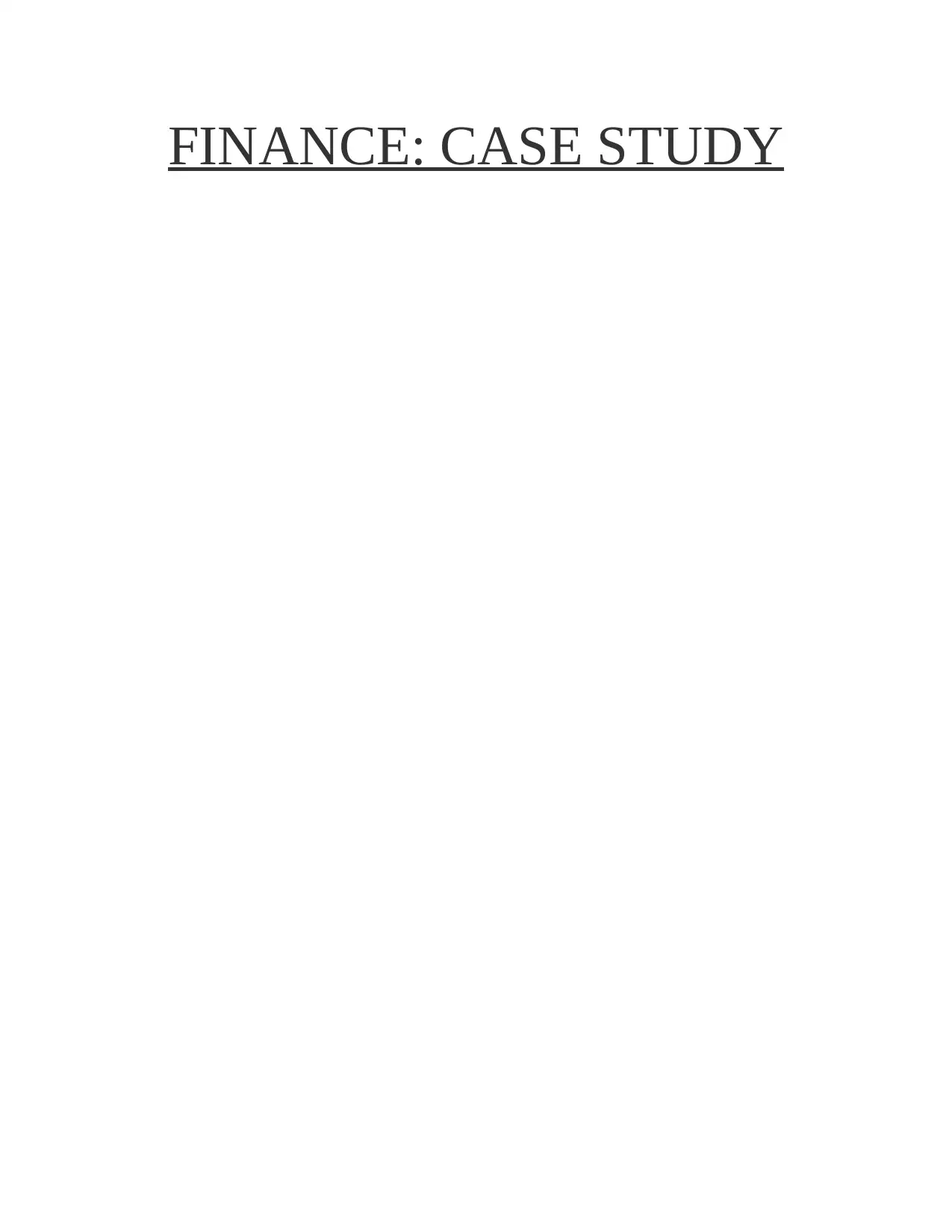
FINANCE: CASE STUDY
Paraphrase This Document
Need a fresh take? Get an instant paraphrase of this document with our AI Paraphraser
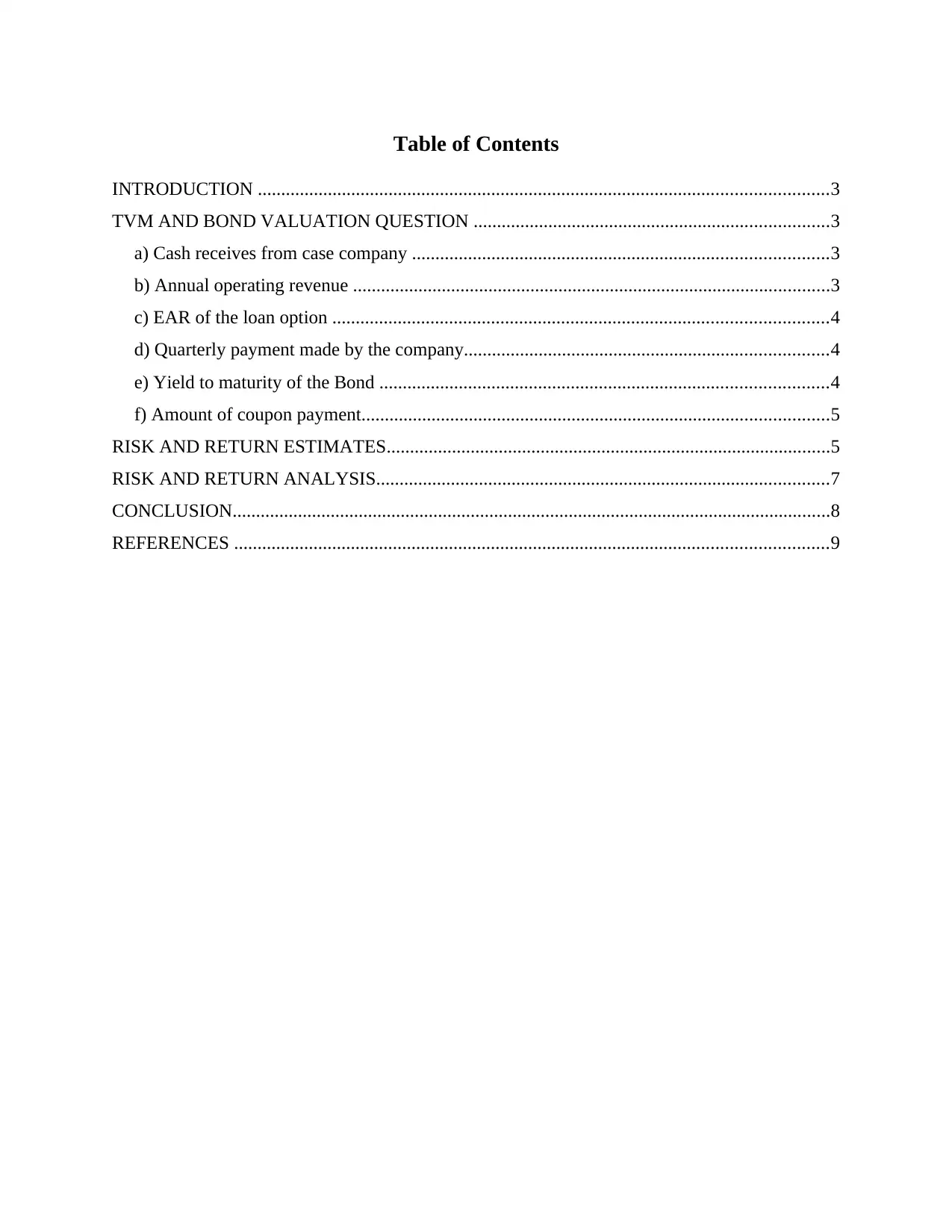
Table of Contents
INTRODUCTION ..........................................................................................................................3
TVM AND BOND VALUATION QUESTION ............................................................................3
a) Cash receives from case company .........................................................................................3
b) Annual operating revenue ......................................................................................................3
c) EAR of the loan option ..........................................................................................................4
d) Quarterly payment made by the company..............................................................................4
e) Yield to maturity of the Bond ................................................................................................4
f) Amount of coupon payment....................................................................................................5
RISK AND RETURN ESTIMATES...............................................................................................5
RISK AND RETURN ANALYSIS.................................................................................................7
CONCLUSION................................................................................................................................8
REFERENCES ...............................................................................................................................9
INTRODUCTION ..........................................................................................................................3
TVM AND BOND VALUATION QUESTION ............................................................................3
a) Cash receives from case company .........................................................................................3
b) Annual operating revenue ......................................................................................................3
c) EAR of the loan option ..........................................................................................................4
d) Quarterly payment made by the company..............................................................................4
e) Yield to maturity of the Bond ................................................................................................4
f) Amount of coupon payment....................................................................................................5
RISK AND RETURN ESTIMATES...............................................................................................5
RISK AND RETURN ANALYSIS.................................................................................................7
CONCLUSION................................................................................................................................8
REFERENCES ...............................................................................................................................9
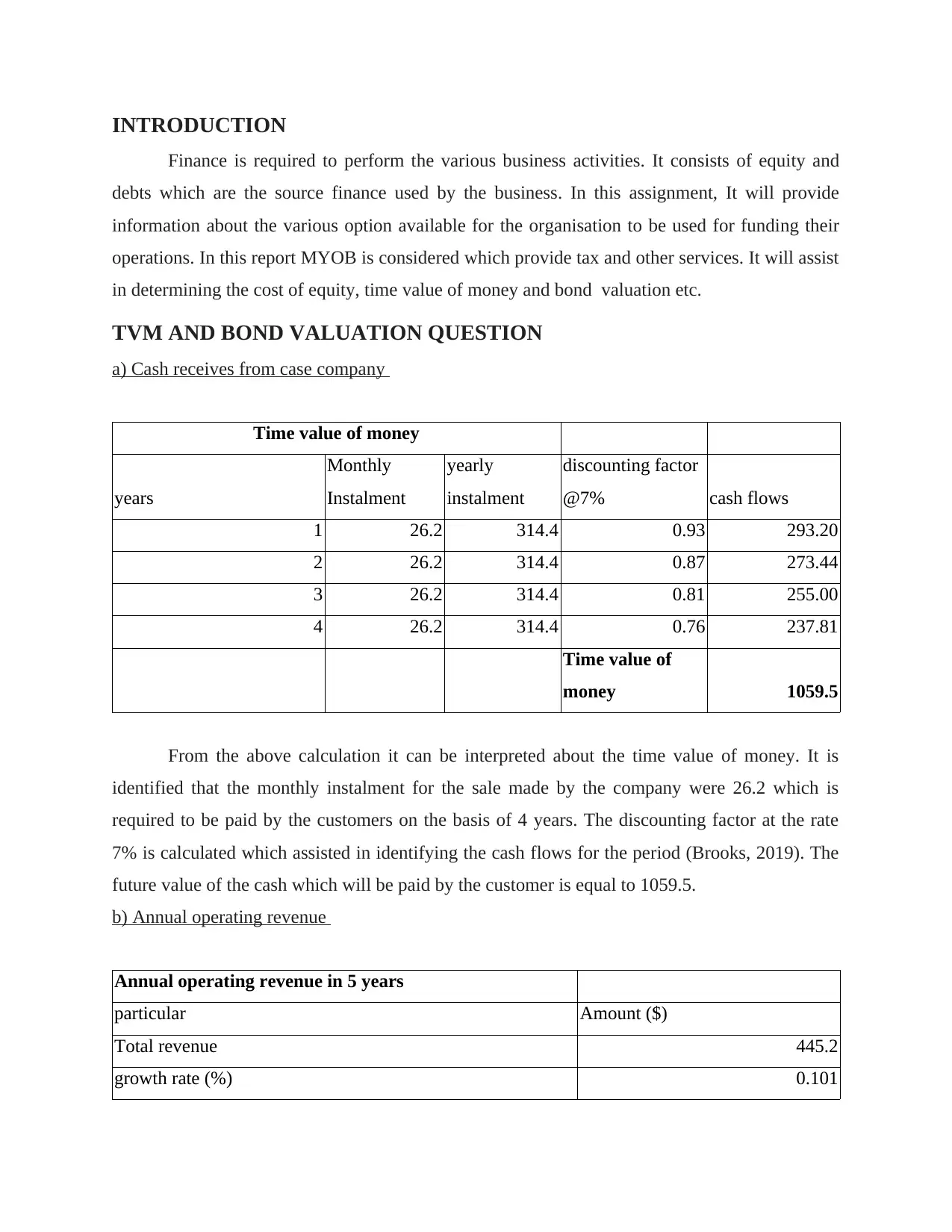
INTRODUCTION
Finance is required to perform the various business activities. It consists of equity and
debts which are the source finance used by the business. In this assignment, It will provide
information about the various option available for the organisation to be used for funding their
operations. In this report MYOB is considered which provide tax and other services. It will assist
in determining the cost of equity, time value of money and bond valuation etc.
TVM AND BOND VALUATION QUESTION
a) Cash receives from case company
Time value of money
years
Monthly
Instalment
yearly
instalment
discounting factor
@7% cash flows
1 26.2 314.4 0.93 293.20
2 26.2 314.4 0.87 273.44
3 26.2 314.4 0.81 255.00
4 26.2 314.4 0.76 237.81
Time value of
money 1059.5
From the above calculation it can be interpreted about the time value of money. It is
identified that the monthly instalment for the sale made by the company were 26.2 which is
required to be paid by the customers on the basis of 4 years. The discounting factor at the rate
7% is calculated which assisted in identifying the cash flows for the period (Brooks, 2019). The
future value of the cash which will be paid by the customer is equal to 1059.5.
b) Annual operating revenue
Annual operating revenue in 5 years
particular Amount ($)
Total revenue 445.2
growth rate (%) 0.101
Finance is required to perform the various business activities. It consists of equity and
debts which are the source finance used by the business. In this assignment, It will provide
information about the various option available for the organisation to be used for funding their
operations. In this report MYOB is considered which provide tax and other services. It will assist
in determining the cost of equity, time value of money and bond valuation etc.
TVM AND BOND VALUATION QUESTION
a) Cash receives from case company
Time value of money
years
Monthly
Instalment
yearly
instalment
discounting factor
@7% cash flows
1 26.2 314.4 0.93 293.20
2 26.2 314.4 0.87 273.44
3 26.2 314.4 0.81 255.00
4 26.2 314.4 0.76 237.81
Time value of
money 1059.5
From the above calculation it can be interpreted about the time value of money. It is
identified that the monthly instalment for the sale made by the company were 26.2 which is
required to be paid by the customers on the basis of 4 years. The discounting factor at the rate
7% is calculated which assisted in identifying the cash flows for the period (Brooks, 2019). The
future value of the cash which will be paid by the customer is equal to 1059.5.
b) Annual operating revenue
Annual operating revenue in 5 years
particular Amount ($)
Total revenue 445.2
growth rate (%) 0.101
⊘ This is a preview!⊘
Do you want full access?
Subscribe today to unlock all pages.

Trusted by 1+ million students worldwide
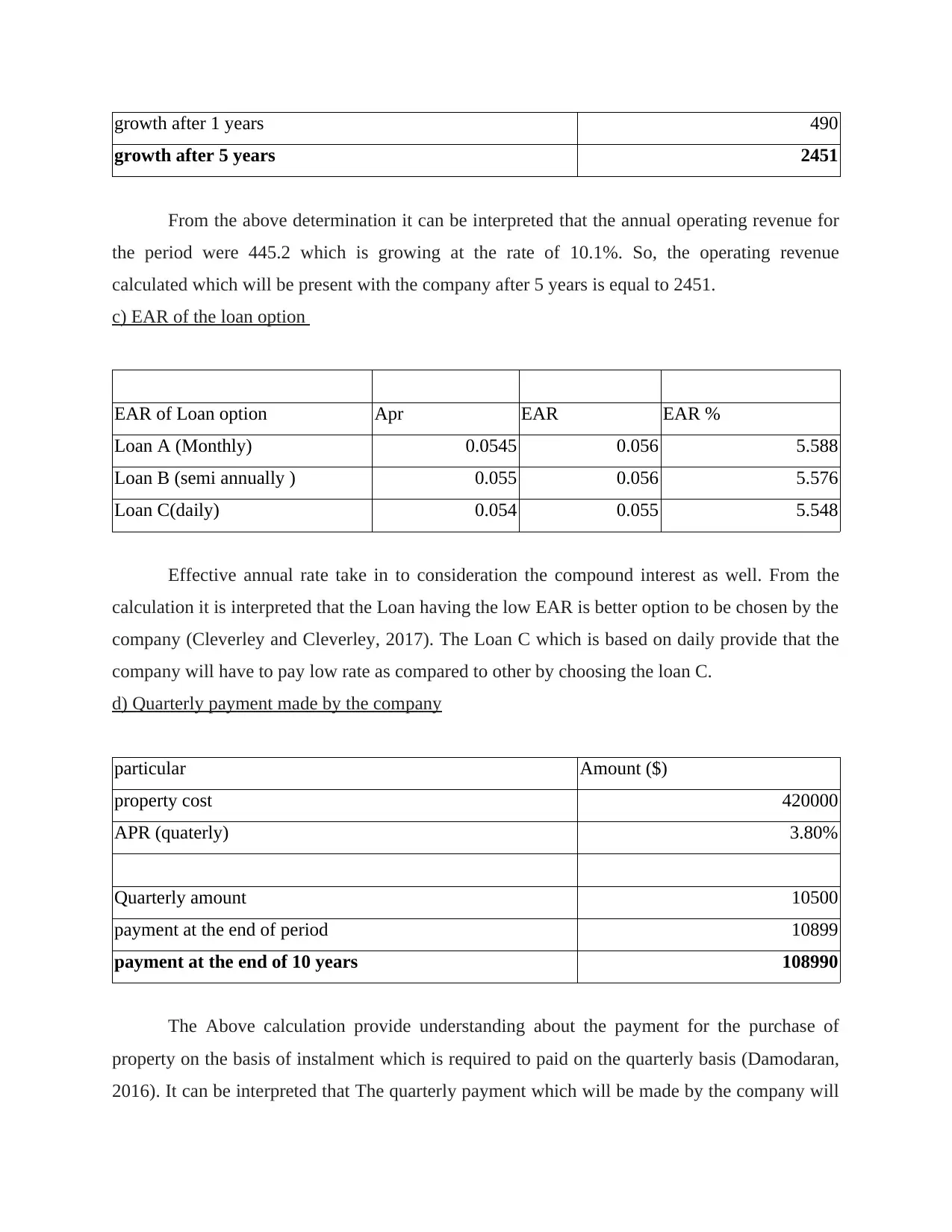
growth after 1 years 490
growth after 5 years 2451
From the above determination it can be interpreted that the annual operating revenue for
the period were 445.2 which is growing at the rate of 10.1%. So, the operating revenue
calculated which will be present with the company after 5 years is equal to 2451.
c) EAR of the loan option
EAR of Loan option Apr EAR EAR %
Loan A (Monthly) 0.0545 0.056 5.588
Loan B (semi annually ) 0.055 0.056 5.576
Loan C(daily) 0.054 0.055 5.548
Effective annual rate take in to consideration the compound interest as well. From the
calculation it is interpreted that the Loan having the low EAR is better option to be chosen by the
company (Cleverley and Cleverley, 2017). The Loan C which is based on daily provide that the
company will have to pay low rate as compared to other by choosing the loan C.
d) Quarterly payment made by the company
particular Amount ($)
property cost 420000
APR (quaterly) 3.80%
Quarterly amount 10500
payment at the end of period 10899
payment at the end of 10 years 108990
The Above calculation provide understanding about the payment for the purchase of
property on the basis of instalment which is required to paid on the quarterly basis (Damodaran,
2016). It can be interpreted that The quarterly payment which will be made by the company will
growth after 5 years 2451
From the above determination it can be interpreted that the annual operating revenue for
the period were 445.2 which is growing at the rate of 10.1%. So, the operating revenue
calculated which will be present with the company after 5 years is equal to 2451.
c) EAR of the loan option
EAR of Loan option Apr EAR EAR %
Loan A (Monthly) 0.0545 0.056 5.588
Loan B (semi annually ) 0.055 0.056 5.576
Loan C(daily) 0.054 0.055 5.548
Effective annual rate take in to consideration the compound interest as well. From the
calculation it is interpreted that the Loan having the low EAR is better option to be chosen by the
company (Cleverley and Cleverley, 2017). The Loan C which is based on daily provide that the
company will have to pay low rate as compared to other by choosing the loan C.
d) Quarterly payment made by the company
particular Amount ($)
property cost 420000
APR (quaterly) 3.80%
Quarterly amount 10500
payment at the end of period 10899
payment at the end of 10 years 108990
The Above calculation provide understanding about the payment for the purchase of
property on the basis of instalment which is required to paid on the quarterly basis (Damodaran,
2016). It can be interpreted that The quarterly payment which will be made by the company will
Paraphrase This Document
Need a fresh take? Get an instant paraphrase of this document with our AI Paraphraser
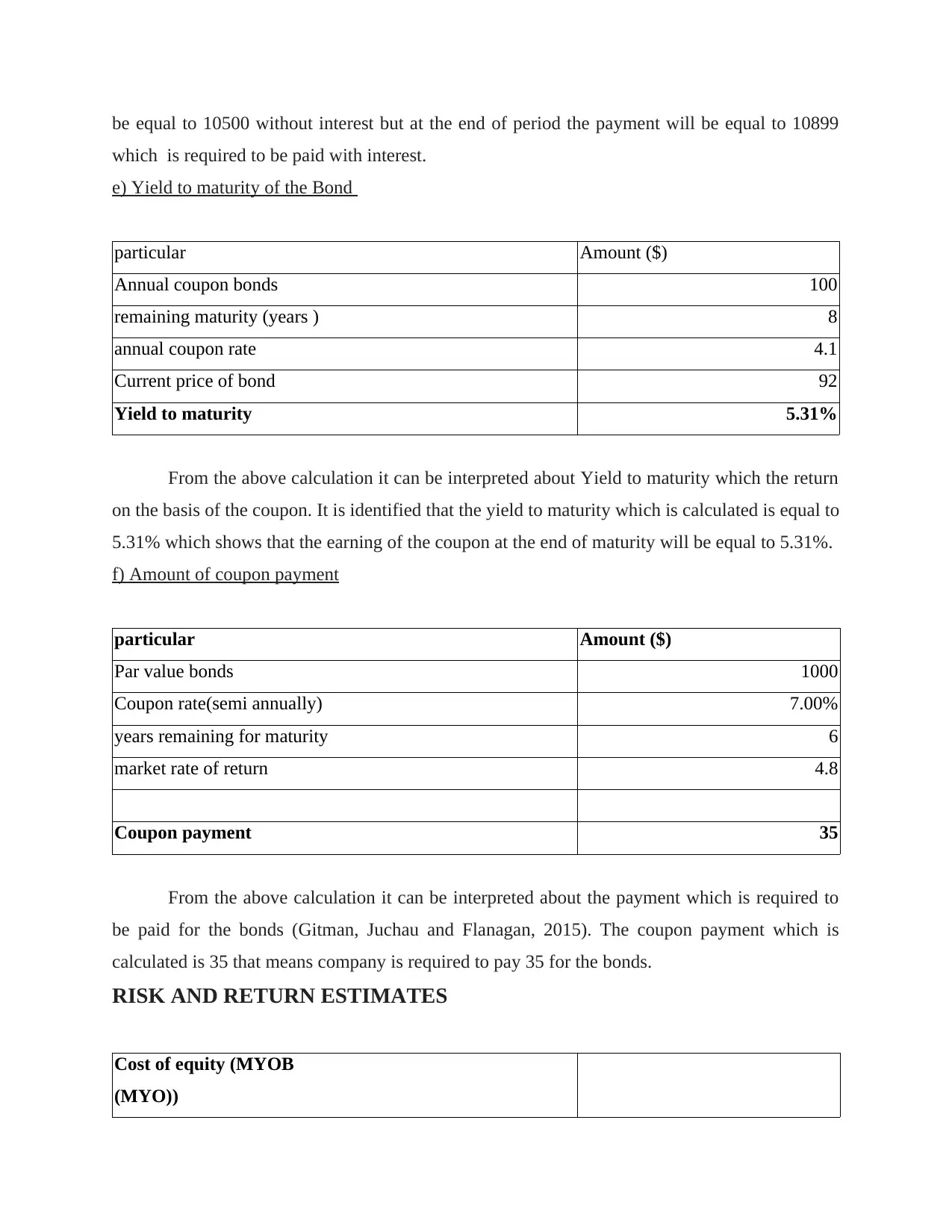
be equal to 10500 without interest but at the end of period the payment will be equal to 10899
which is required to be paid with interest.
e) Yield to maturity of the Bond
particular Amount ($)
Annual coupon bonds 100
remaining maturity (years ) 8
annual coupon rate 4.1
Current price of bond 92
Yield to maturity 5.31%
From the above calculation it can be interpreted about Yield to maturity which the return
on the basis of the coupon. It is identified that the yield to maturity which is calculated is equal to
5.31% which shows that the earning of the coupon at the end of maturity will be equal to 5.31%.
f) Amount of coupon payment
particular Amount ($)
Par value bonds 1000
Coupon rate(semi annually) 7.00%
years remaining for maturity 6
market rate of return 4.8
Coupon payment 35
From the above calculation it can be interpreted about the payment which is required to
be paid for the bonds (Gitman, Juchau and Flanagan, 2015). The coupon payment which is
calculated is 35 that means company is required to pay 35 for the bonds.
RISK AND RETURN ESTIMATES
Cost of equity (MYOB
(MYO))
which is required to be paid with interest.
e) Yield to maturity of the Bond
particular Amount ($)
Annual coupon bonds 100
remaining maturity (years ) 8
annual coupon rate 4.1
Current price of bond 92
Yield to maturity 5.31%
From the above calculation it can be interpreted about Yield to maturity which the return
on the basis of the coupon. It is identified that the yield to maturity which is calculated is equal to
5.31% which shows that the earning of the coupon at the end of maturity will be equal to 5.31%.
f) Amount of coupon payment
particular Amount ($)
Par value bonds 1000
Coupon rate(semi annually) 7.00%
years remaining for maturity 6
market rate of return 4.8
Coupon payment 35
From the above calculation it can be interpreted about the payment which is required to
be paid for the bonds (Gitman, Juchau and Flanagan, 2015). The coupon payment which is
calculated is 35 that means company is required to pay 35 for the bonds.
RISK AND RETURN ESTIMATES
Cost of equity (MYOB
(MYO))
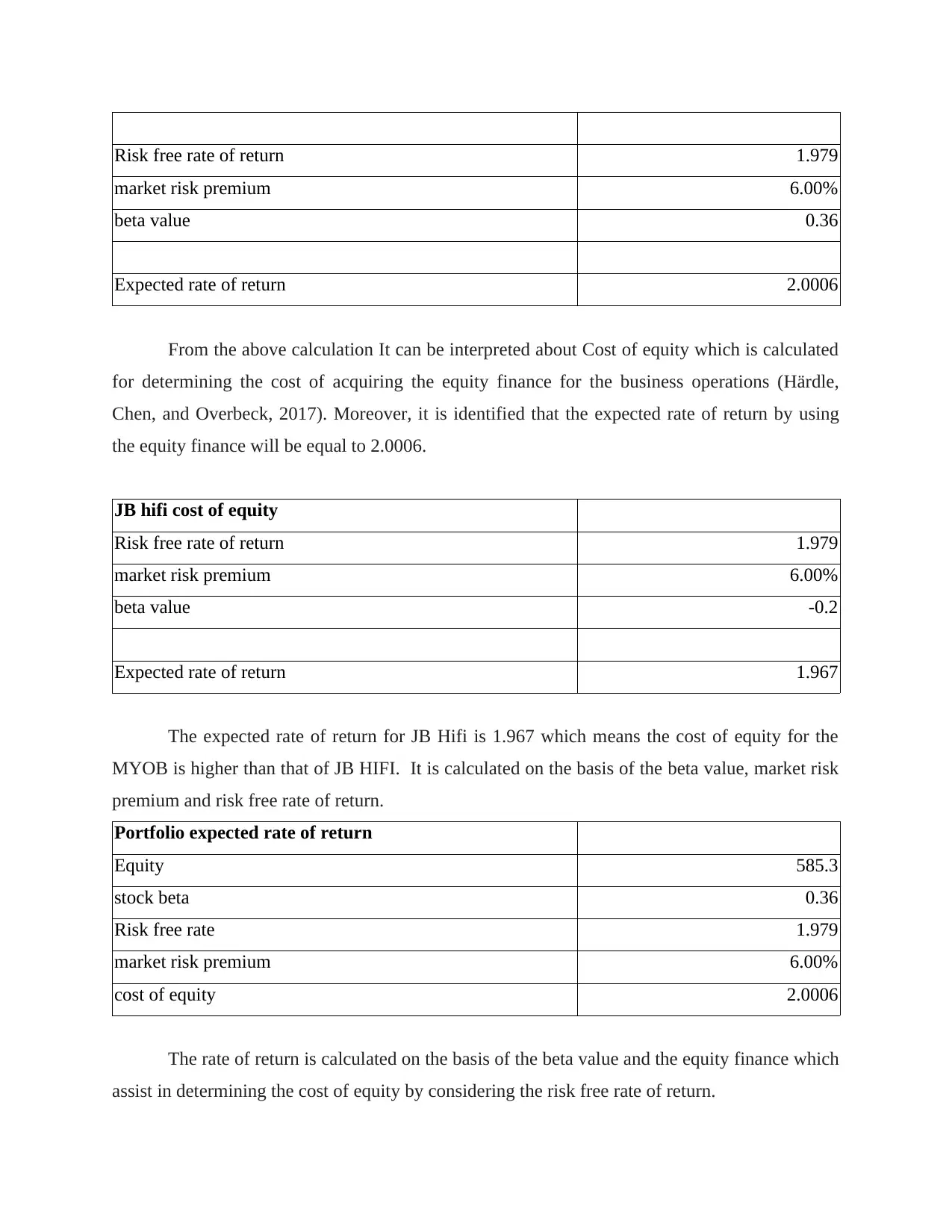
Risk free rate of return 1.979
market risk premium 6.00%
beta value 0.36
Expected rate of return 2.0006
From the above calculation It can be interpreted about Cost of equity which is calculated
for determining the cost of acquiring the equity finance for the business operations (Härdle,
Chen, and Overbeck, 2017). Moreover, it is identified that the expected rate of return by using
the equity finance will be equal to 2.0006.
JB hifi cost of equity
Risk free rate of return 1.979
market risk premium 6.00%
beta value -0.2
Expected rate of return 1.967
The expected rate of return for JB Hifi is 1.967 which means the cost of equity for the
MYOB is higher than that of JB HIFI. It is calculated on the basis of the beta value, market risk
premium and risk free rate of return.
Portfolio expected rate of return
Equity 585.3
stock beta 0.36
Risk free rate 1.979
market risk premium 6.00%
cost of equity 2.0006
The rate of return is calculated on the basis of the beta value and the equity finance which
assist in determining the cost of equity by considering the risk free rate of return.
market risk premium 6.00%
beta value 0.36
Expected rate of return 2.0006
From the above calculation It can be interpreted about Cost of equity which is calculated
for determining the cost of acquiring the equity finance for the business operations (Härdle,
Chen, and Overbeck, 2017). Moreover, it is identified that the expected rate of return by using
the equity finance will be equal to 2.0006.
JB hifi cost of equity
Risk free rate of return 1.979
market risk premium 6.00%
beta value -0.2
Expected rate of return 1.967
The expected rate of return for JB Hifi is 1.967 which means the cost of equity for the
MYOB is higher than that of JB HIFI. It is calculated on the basis of the beta value, market risk
premium and risk free rate of return.
Portfolio expected rate of return
Equity 585.3
stock beta 0.36
Risk free rate 1.979
market risk premium 6.00%
cost of equity 2.0006
The rate of return is calculated on the basis of the beta value and the equity finance which
assist in determining the cost of equity by considering the risk free rate of return.
⊘ This is a preview!⊘
Do you want full access?
Subscribe today to unlock all pages.

Trusted by 1+ million students worldwide
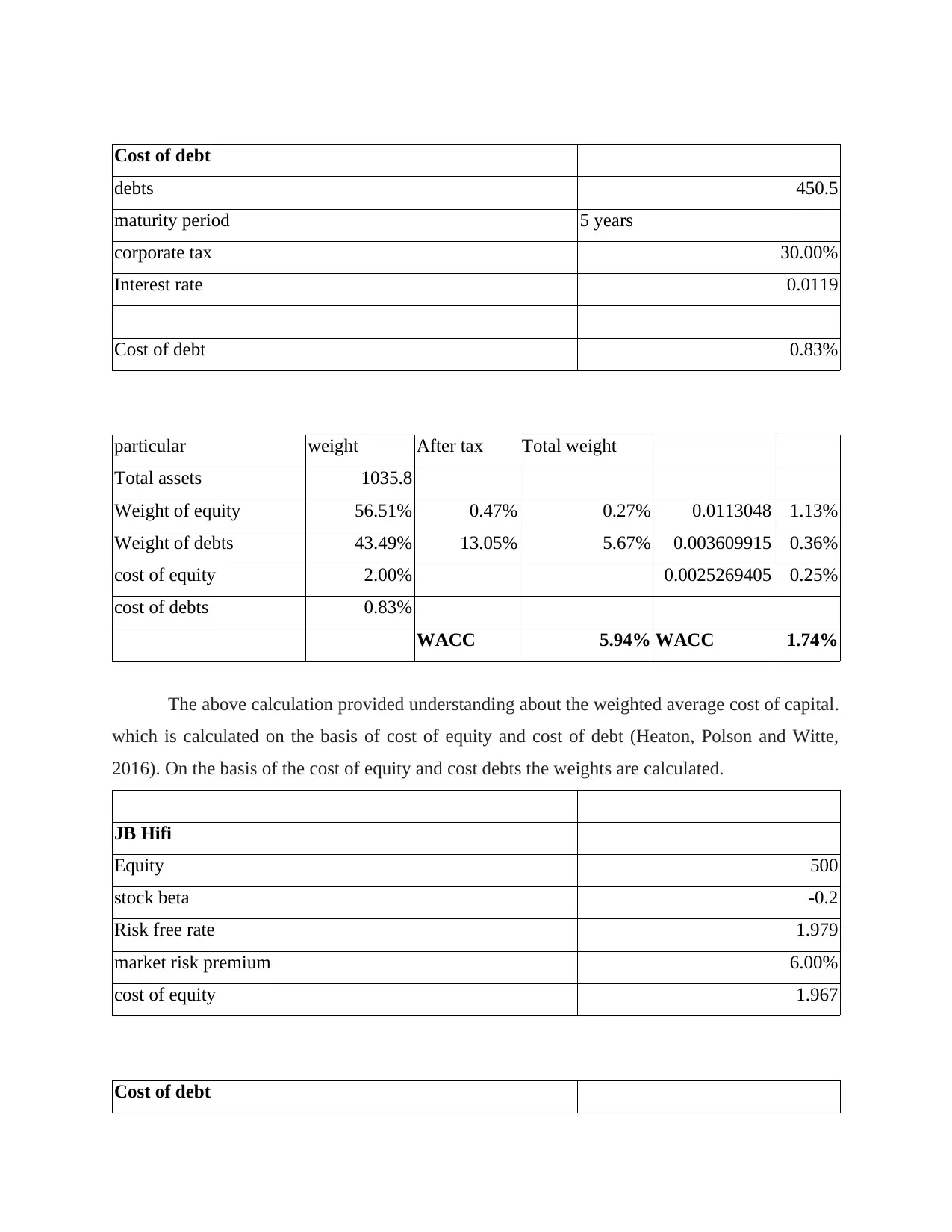
Cost of debt
debts 450.5
maturity period 5 years
corporate tax 30.00%
Interest rate 0.0119
Cost of debt 0.83%
particular weight After tax Total weight
Total assets 1035.8
Weight of equity 56.51% 0.47% 0.27% 0.0113048 1.13%
Weight of debts 43.49% 13.05% 5.67% 0.003609915 0.36%
cost of equity 2.00% 0.0025269405 0.25%
cost of debts 0.83%
WACC 5.94% WACC 1.74%
The above calculation provided understanding about the weighted average cost of capital.
which is calculated on the basis of cost of equity and cost of debt (Heaton, Polson and Witte,
2016). On the basis of the cost of equity and cost debts the weights are calculated.
JB Hifi
Equity 500
stock beta -0.2
Risk free rate 1.979
market risk premium 6.00%
cost of equity 1.967
Cost of debt
debts 450.5
maturity period 5 years
corporate tax 30.00%
Interest rate 0.0119
Cost of debt 0.83%
particular weight After tax Total weight
Total assets 1035.8
Weight of equity 56.51% 0.47% 0.27% 0.0113048 1.13%
Weight of debts 43.49% 13.05% 5.67% 0.003609915 0.36%
cost of equity 2.00% 0.0025269405 0.25%
cost of debts 0.83%
WACC 5.94% WACC 1.74%
The above calculation provided understanding about the weighted average cost of capital.
which is calculated on the basis of cost of equity and cost of debt (Heaton, Polson and Witte,
2016). On the basis of the cost of equity and cost debts the weights are calculated.
JB Hifi
Equity 500
stock beta -0.2
Risk free rate 1.979
market risk premium 6.00%
cost of equity 1.967
Cost of debt
Paraphrase This Document
Need a fresh take? Get an instant paraphrase of this document with our AI Paraphraser
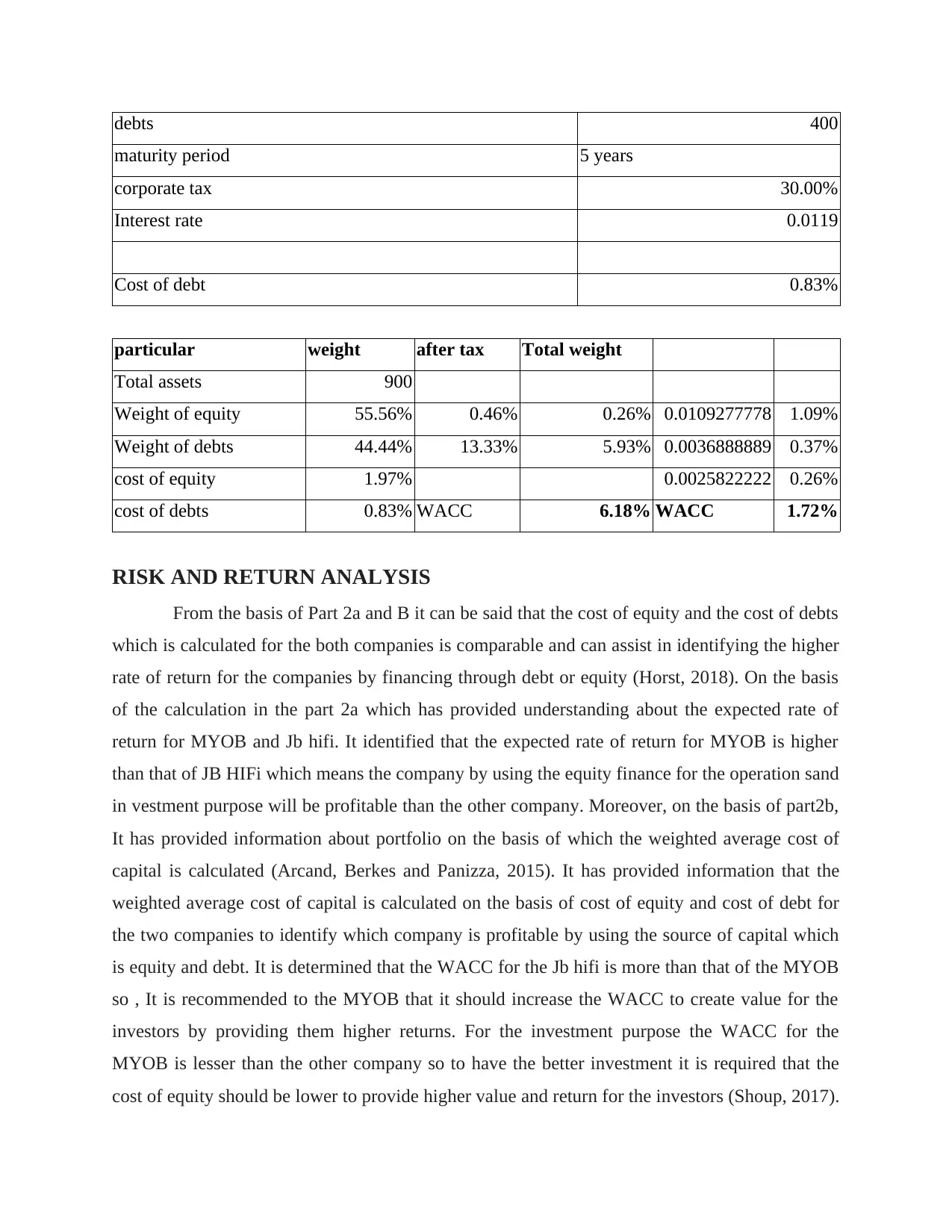
debts 400
maturity period 5 years
corporate tax 30.00%
Interest rate 0.0119
Cost of debt 0.83%
particular weight after tax Total weight
Total assets 900
Weight of equity 55.56% 0.46% 0.26% 0.0109277778 1.09%
Weight of debts 44.44% 13.33% 5.93% 0.0036888889 0.37%
cost of equity 1.97% 0.0025822222 0.26%
cost of debts 0.83% WACC 6.18% WACC 1.72%
RISK AND RETURN ANALYSIS
From the basis of Part 2a and B it can be said that the cost of equity and the cost of debts
which is calculated for the both companies is comparable and can assist in identifying the higher
rate of return for the companies by financing through debt or equity (Horst, 2018). On the basis
of the calculation in the part 2a which has provided understanding about the expected rate of
return for MYOB and Jb hifi. It identified that the expected rate of return for MYOB is higher
than that of JB HIFi which means the company by using the equity finance for the operation sand
in vestment purpose will be profitable than the other company. Moreover, on the basis of part2b,
It has provided information about portfolio on the basis of which the weighted average cost of
capital is calculated (Arcand, Berkes and Panizza, 2015). It has provided information that the
weighted average cost of capital is calculated on the basis of cost of equity and cost of debt for
the two companies to identify which company is profitable by using the source of capital which
is equity and debt. It is determined that the WACC for the Jb hifi is more than that of the MYOB
so , It is recommended to the MYOB that it should increase the WACC to create value for the
investors by providing them higher returns. For the investment purpose the WACC for the
MYOB is lesser than the other company so to have the better investment it is required that the
cost of equity should be lower to provide higher value and return for the investors (Shoup, 2017).
maturity period 5 years
corporate tax 30.00%
Interest rate 0.0119
Cost of debt 0.83%
particular weight after tax Total weight
Total assets 900
Weight of equity 55.56% 0.46% 0.26% 0.0109277778 1.09%
Weight of debts 44.44% 13.33% 5.93% 0.0036888889 0.37%
cost of equity 1.97% 0.0025822222 0.26%
cost of debts 0.83% WACC 6.18% WACC 1.72%
RISK AND RETURN ANALYSIS
From the basis of Part 2a and B it can be said that the cost of equity and the cost of debts
which is calculated for the both companies is comparable and can assist in identifying the higher
rate of return for the companies by financing through debt or equity (Horst, 2018). On the basis
of the calculation in the part 2a which has provided understanding about the expected rate of
return for MYOB and Jb hifi. It identified that the expected rate of return for MYOB is higher
than that of JB HIFi which means the company by using the equity finance for the operation sand
in vestment purpose will be profitable than the other company. Moreover, on the basis of part2b,
It has provided information about portfolio on the basis of which the weighted average cost of
capital is calculated (Arcand, Berkes and Panizza, 2015). It has provided information that the
weighted average cost of capital is calculated on the basis of cost of equity and cost of debt for
the two companies to identify which company is profitable by using the source of capital which
is equity and debt. It is determined that the WACC for the Jb hifi is more than that of the MYOB
so , It is recommended to the MYOB that it should increase the WACC to create value for the
investors by providing them higher returns. For the investment purpose the WACC for the
MYOB is lesser than the other company so to have the better investment it is required that the
cost of equity should be lower to provide higher value and return for the investors (Shoup, 2017).
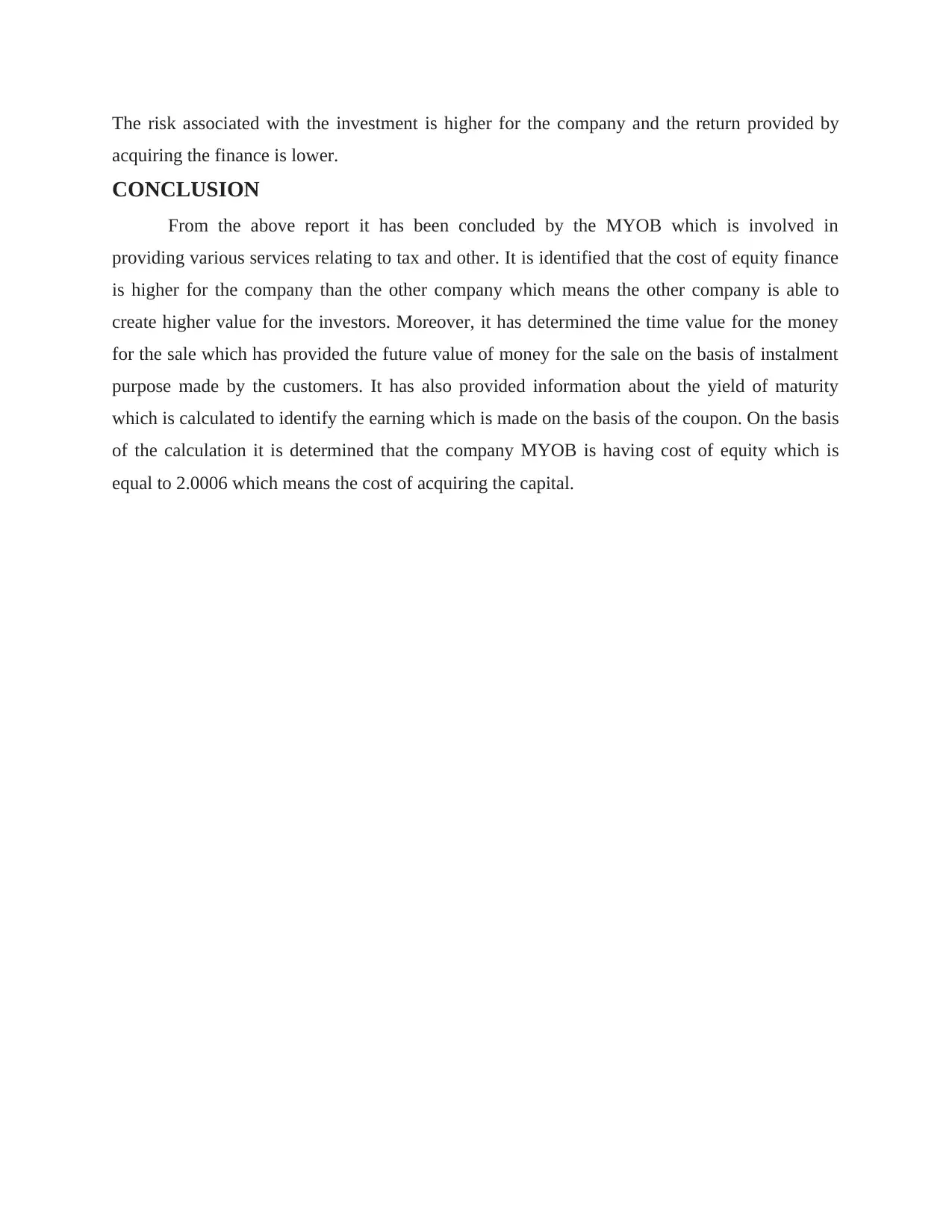
The risk associated with the investment is higher for the company and the return provided by
acquiring the finance is lower.
CONCLUSION
From the above report it has been concluded by the MYOB which is involved in
providing various services relating to tax and other. It is identified that the cost of equity finance
is higher for the company than the other company which means the other company is able to
create higher value for the investors. Moreover, it has determined the time value for the money
for the sale which has provided the future value of money for the sale on the basis of instalment
purpose made by the customers. It has also provided information about the yield of maturity
which is calculated to identify the earning which is made on the basis of the coupon. On the basis
of the calculation it is determined that the company MYOB is having cost of equity which is
equal to 2.0006 which means the cost of acquiring the capital.
acquiring the finance is lower.
CONCLUSION
From the above report it has been concluded by the MYOB which is involved in
providing various services relating to tax and other. It is identified that the cost of equity finance
is higher for the company than the other company which means the other company is able to
create higher value for the investors. Moreover, it has determined the time value for the money
for the sale which has provided the future value of money for the sale on the basis of instalment
purpose made by the customers. It has also provided information about the yield of maturity
which is calculated to identify the earning which is made on the basis of the coupon. On the basis
of the calculation it is determined that the company MYOB is having cost of equity which is
equal to 2.0006 which means the cost of acquiring the capital.
⊘ This is a preview!⊘
Do you want full access?
Subscribe today to unlock all pages.

Trusted by 1+ million students worldwide
1 out of 9
Related Documents
Your All-in-One AI-Powered Toolkit for Academic Success.
+13062052269
info@desklib.com
Available 24*7 on WhatsApp / Email
![[object Object]](/_next/static/media/star-bottom.7253800d.svg)
Unlock your academic potential
Copyright © 2020–2025 A2Z Services. All Rights Reserved. Developed and managed by ZUCOL.





